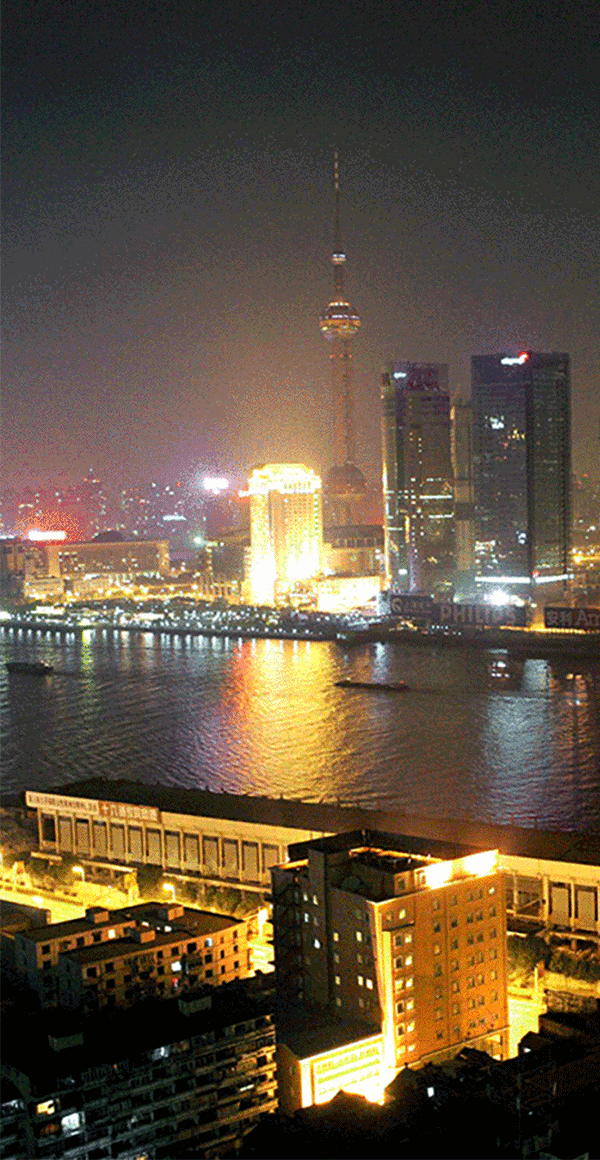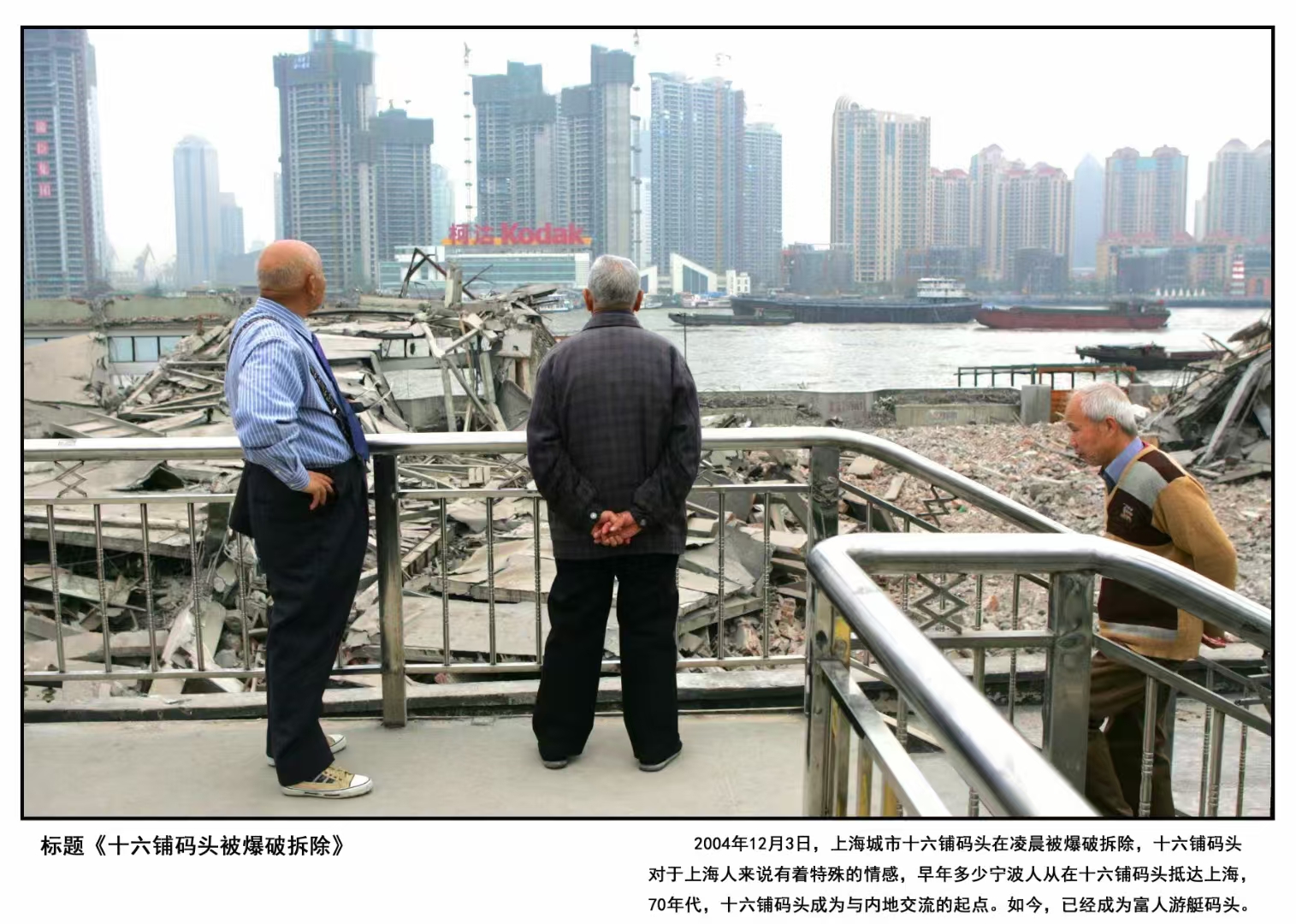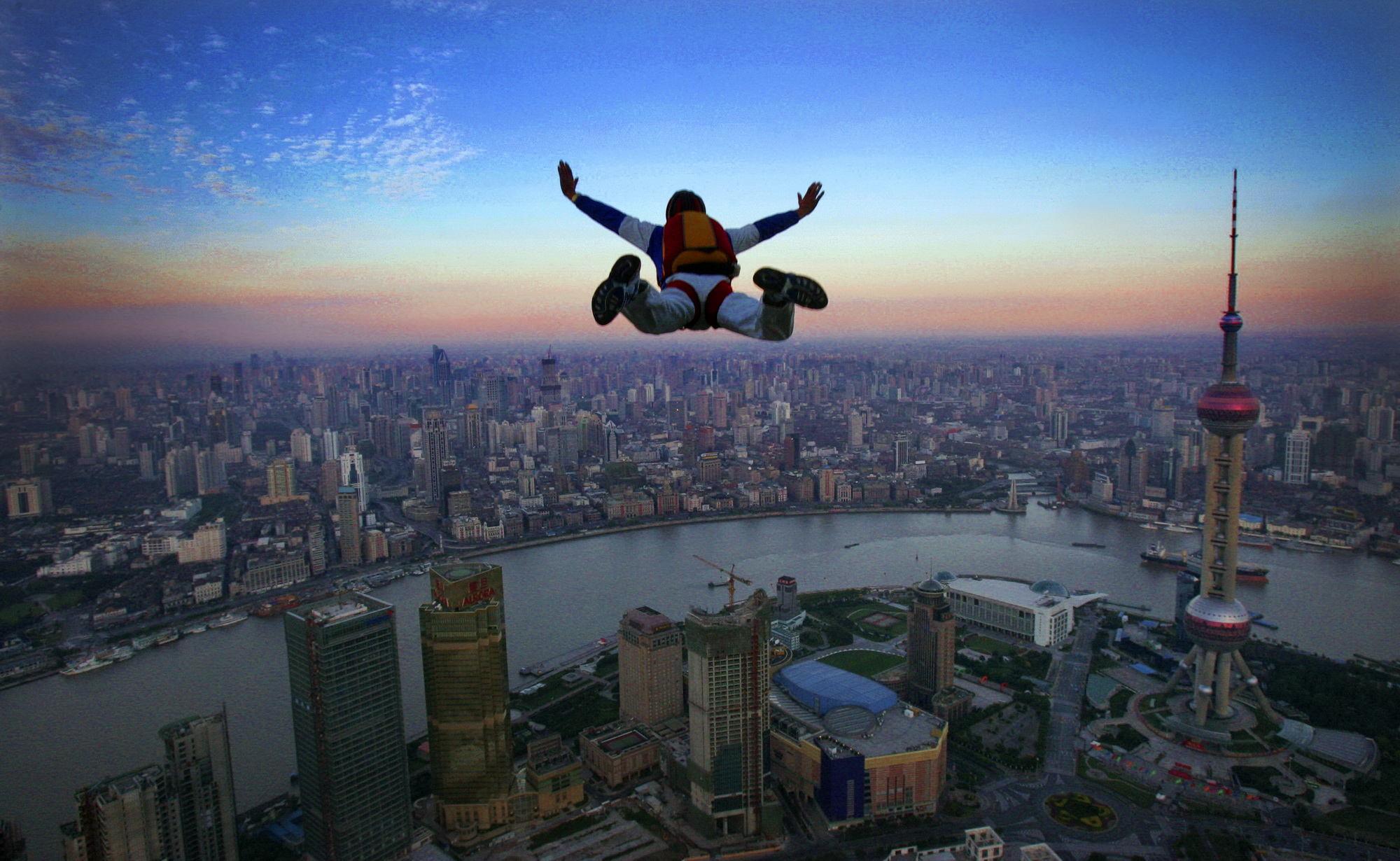
Tranalysis
50 seconds later, Shiliupu Passenger Terminal disappeared
At 00:59 a.m. on December 3, 2004, the waiting building and Shenke Hotel of Shanghai Shiliupu Passenger Terminal were successfully demolished. The Shiliupu Passenger Terminal, which has a history of more than 140 years, bid farewell to the historical stage. Wang Jie, chairman of the Shanghai City Photographers Association, pointed to another photo taken and recalled,"Most of the people living in Shanghai now have ancestors who came from Shiliupu Wharf, especially those from Ningbo, Zhejiang who have settled in Shanghai. They basically all landed in Shanghai from Shiliupu Wharf. For old Shanghainese, Shiliupu Wharf has special feelings."

On December 3, 2004, the Shiliupu Pier was demolished by blasting. Photo by Wang Jie
In the 1950s and 1960s, Shiliupu Pier was a gateway to and from Shanghai. Wang Jie said that he had a "deep" memory of it. At the age of 12, because he was going to spend the summer vacation with his father, who was serving as a soldier in Yancheng, Jiangsu Province, his mother could not accompany him due to work, so she sent him to Shiliupu Wharf. After countless instructions, Xiao Wang Jie carried the big bags and bags alone boarded the "Dongfanghong" ship to Nantong, and then transferred to the long-distance bus to Yancheng. Half a century later, the function of Shiliupu Passenger Terminal is changing, replaced by new productivity and a new lifestyle.

On December 3, 2004, with a dull explosion, the 140-year-old Shiliupu Pier completely disappeared in about 50 seconds. Photo by Wang Jie
Wang Jie recalled,"Before 1 o'clock, the commander issued an order to blast. At that time, the engineers at the security points around the dock received orders from the intercom. Then, a muffled explosion sounded from south to north. It was about 50 seconds. First, the ten-story Shenke Hotel, and then the 19-meter-high passenger terminal waiting ship building of the 16-shop passenger terminal with a total of 39 spans, each span of 19 meters high. The building collapsed southward one by one."
After the explosion, Shanghai citizens learned the news from the radio and came to the scene one after another to bid farewell to the Shiliupu Pier, which carries the memory of Shanghai people. The old man wearing bib trousers on the left side of the picture below once told Wang Jie that he had come to Shanghai from "Shiliu Shop" in the past and had special feelings for it.

On December 3, 2004, after the Shiliupu Pier was blasted, Shanghai citizens came to the scene to bid farewell. Photo by Wang Jie
Shiliupu Wharf carries the feelings and memories of Shanghai people. Shanghai's urban development cannot be separated from Shiliupu Wharf. Shiliupu Wharf is the first "springboard" for Ningbo people to arrive in Shanghai. It is also the starting point for Shanghai's educated youth to queue up in the mainland to settle down and receive farmers 're-education. Today, the Shiliupu Pier has been demolished and transformed into a pier and leisure area for private luxury yachts.
The tallest building in Pudong--the Zeus Fire Watchtower--was blasted
"My BB phone at that time was called by Yida, and the number was 126." Wang Jie recalled pointing to a huge advertisement on the top floor of a building that was collapsing in the photo. This photo was taken on September 13, 1999. The photographer was Wang Jie himself when the Zeus Fire Watchtower, the tallest building in Pudong, Shanghai, was blown up.

On September 13, 1999, the Zeus Fire Watchtower exploded. Photo by Wang Jie
On February 1, 2002, the warehouse of the Yangjiadu plot of Shanghai Port Dongchang Company on the other side of Jinling Road in Puxi was blasted, sounding the clarion call for comprehensive development on both sides of Pudong. Now the 24-kilometer coastline along the Pudong Riverside has been fully connected. As a witness, witness and recorder of Pudong's development and opening up, on October 31, 2024, The Paper News interviewed Wang Jie, then director of the Photography Department of Shanghai News Morning Post and current chairman of the Shanghai City Photographers Association. From the decommissioning of the Dongchang Fire Tower to the blasting of Shiliupu Wharf, the historical moments under Wang Jie's lens, little-known but vivid stories of Shanghai, bring us back to Shanghai more than 20 years ago.
Once upon a time, fire alarms were observed with your eyes
"From this picture, you can see the changes in the entire Lujiazui, and the development and opening up of Pudong can be seen." Wang Jie pointed to the photo and said leisurely,"Pudong used to be a flat land. This watchtower was the tallest building at that time. Its function was to observe the fire. It was a fire watchtower that transmitted the fire through manual means. Firefighters were on duty 24 hours a day on the tower. After discovering the fire, they immediately notified the fire brigade to go out to put out the fire, which played a huge role at that time."
The Zeus Fire Observatory Tower, built in 1954, has been the "tallest in Pudong" since its completion until the mid-1980s. The development and opening up of Pudong has repeatedly refreshed the height of Lujiazui. This watchtower has changed from the original "tall" in Pudong to the "little". The increasing number of tall buildings in the surrounding area gradually blocked the view of the watchtower, and the way of manual observation of the fire cannot keep up with the pace of the times and the needs of the city. With the opening of the 119 fire alarm telephone, this watchtower was officially suspended in 1995.

On September 13, 1999, the Zeus Fire Watchtower was blasted. Photo by Wang Jie
The Zeus Fire Watchtower instantly toppled with a loud noise. Wang Jie stepped on the roof of a residential building opposite the watchtower in advance and recorded this precious historical photos. "Watching the explosion of this building feels like a farewell party." Wang Jie lamented,"A building around me disappeared. It's like losing a friend I see every day. I feel sad." During this time, Wang Jie posted "Picture of the Day" in his circle of friends every day. The content is exactly the bits and pieces of Shanghai recorded many years ago, including this photo. In this way, he bid farewell to this era step by step.
"There is another interesting thing." Wang Jie observed that as the tallest building in Pudong at that time, many companies would advertise on the watchtower, but with the explosion of the watchtower, these billboards and even advertising companies also disappeared. Yida paging was one of them."This is also a witness to the development of the times." Before he could finish speaking, Wang Jie showed a news photo of the "Labor Dispute at Haixing Paging Station" taken in 2002.

On September 17, 2002, Haixing Paging Station, which was on the verge of bankruptcy due to its high debt, was auctioned at an auction hosted by Shanghai New Century Auction Company, by Guomai Company, the leader in the paging industry in Shanghai, at a base price of 500,000 yuan. Photo by Wang Jie
BP machines, also known as pagers or pagers, were popular communication tools in the 1990s. At that time, having a BP machine at his waist was definitely a "rich or expensive" person. Sometimes a "doo doo" sound suddenly sounds around you. I saw someone holding his head high and pulling out the BP machine from his waist. He looked down at a string of numbers, then picked up the "mobile phone" that he was always in his hand and "shouted" loudly into the microphone. The whole process is definitely a show of "noble" behavior and a show off that makes people "envy".
With the rapid development of society and the continuous updating of technology, the era of pagers has come to the end, and its former favorite has become abandoned. "A few years later, the indispensable daily necessities around us at that time will also line up to bid farewell to life and squeeze into the history museum." Wang Jie said with a smile.
Record Jin Mao's low-altitude parachute jump
On October 6, 2003, 15 of the world's top low-altitude skydivers jumped off the 88th floor platform of Shanghai Jinmao Tower, with a jump height of 345 meters, exceeding the 280 meters jump height of Malaysia's "Twin Towers" performance parachute performance, setting a new record for skydiving in a high-rise building in the world. At that time, the 420.5-meter-high Jinmao Building was the third tallest building in the world.

In the early morning of October 6, 2003, on the platform of the 88th floor of Jinmao Building, a low-altitude skydiver faced the morning light and jumped into the blue sky like an eagle spreading its wings. Photo by Wang Jie

On October 6, 2003, a group of construction workers watched a low-altitude parachute diving performance downstairs of Jinmao Building. Photo by Wang Jie
As a landmark building in Shanghai and a symbol of Pudong's development, the pagoda-like Jinmao Building stands in the Lujiazui Financial and Trade Zone on the east bank of the Huangpu River. It was originally a field of farmland and workshops. In April 1990, the State Council officially announced the development and opening up of Pudong. In just 13 years, Pudong has built more than 400 modern high-rise buildings and attracted more than 9000 foreign investment projects from more than 80 countries and regions, with a total foreign investment exceeding 40 billion US dollars. Pudong has become "the epitome of Shanghai's modernization drive" and "a symbol of China's reform and opening up." It has been praised by international public opinion as "the most dynamic place in the world."

On October 6, 2003, low-altitude skydivers jumped off the 88th floor platform of Jinmao Building, the "tallest building in China". Photo by Wang Jie
Love the "old Shanghainese" of each river
Wang Jiesheng grew up in Shanghai and has very special feelings for Suzhou River and Huangpu River. "When I was a child, my family lived on Jiangning Road and Macau Road, and behind my home is Jiangning Road and Bridge. Xiao Chenguang was happy to go swimming in the Suzhou River. He remembered that the water was not very clean at that time, but it was actually quite black and smelly. Now it is completely different. "Wang Jie said.
Wang Jie's camera couldn't escape everything that happened on the Huangpu River. He used his lens to record not only the launch of the last giant ship at the Shanghai Shipyard, but also the launch of the first private yacht, and the overall repair of Baidu a century ago. He also recorded the F1 motorboat race and the wedding of a Huangpu River cruise ship... He said that the Huangpu River was the starting point of his life. "I remember my first date with my girlfriend was at the Lovers Wall by the Bund. At that time, after watching the photo exhibition, we bought butterfly cakes and two bottles of milk. We were watching the river scenery by the Bund and fell in love." Today's Huangpu River is completely different, Wang Jie lamented. Its function has changed from industrial water transportation to leisure and sightseeing. "Not long ago, when I accompanied guests from the Yangtze River Delta on a night cruise on a Pujiang cruise ship, I saw the beautiful colors and colors on both sides of the Pujiang River. You thought it was really the saying-'City makes life better.'"

On August 20, 2004, the last "Made in Shanghai" ocean-going giant ship "Jiaxiang Mountain" in the century-old shipbuilding history of Shanghai's Lujiazui area was named and launched. Subsequently, most of the docks and slipways here will be gradually demolished, and the shipbuilding history of Lujiazui will also come to an end. Photo by Wang Jie

The first private yacht launched in the Huangpu River. Photo by Wang Jie

From July 31 to August 1, 2004, the Bund section of Shanghai's Huangpu River was closed for the first time for sports events. This sporting event is the Shanghai leg of the F1 Motorboat Grand Prix. Photo by Wang Jie
Be a photojournalist who has no regrets
During the process of urban iteration, some old buildings of historical value were unfortunately demolished. Along with them, there were memories in people's hearts. In this regard, Wang Jie believes that the development of any city is from primary, intermediate to advanced. It has gone from the original version 1.0, which meets people's basic living needs, to version 2.0 or even 3.0, which meets people's enjoyment of life. In this process, although there may seem to be some regrets, society must move forward if it wants to develop. This is an inevitable law of social development. As a media person,"What I can do is record them all. Those photos may not have much insight at the time, but when you look back a few years later, you will feel very shocked. News photography has two major functions-documentary and historical materials. This is what we often hear. The news is 'yesterday's story, today's news, tomorrow's history'. I can't stop the pace of history. I can only keep recording and let young people understand Shanghai's history through photos. This is my mission and responsibility. I want to be a reporter who has no regrets." Wang Jie said.
